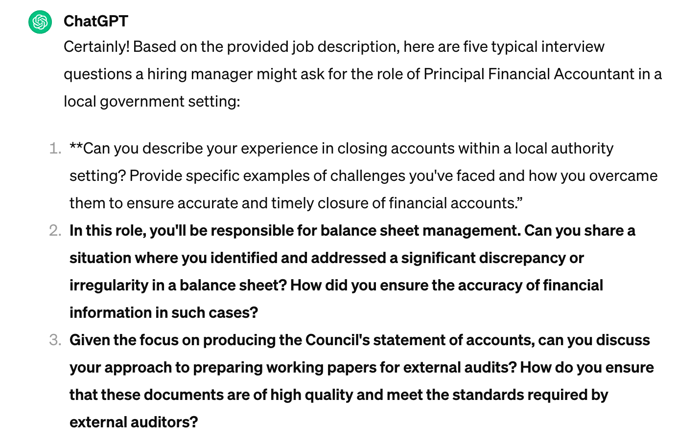Support your job search with generative AI
 In today's rapidly evolving job market, staying ahead of the curve is essential. One way to gain a competitive edge is by learning how to responsibly leverage the power of generative AI.
In today's rapidly evolving job market, staying ahead of the curve is essential. One way to gain a competitive edge is by learning how to responsibly leverage the power of generative AI.
This cutting-edge technology has the potential to transform the way we approach job hunting, from enhancing CVs and cover letters to streamlining the entire process.
However, this technology also comes with its share of risks. You need to ensure you understand the software's policy on data protection and the potential for plagiarised content.
While these tools can make your job hunt easier, you shouldn't use them to complete the entire application process for you (and employers are increasingly training hiring managers to spot and reject AI generated applications).
In this blog, we'll explore what generative AI is, how to use it to bolster your professional documents, how an employer may use AI, ways to reduce associated risks, and highlight some top AI tools to supercharge your job hunt.
Check out our webinar or read on to learn more!
2. Ways to leverage AI for your job applications
3. How might employers use AI when recruiting?
4. How to mitigate the risks of using AI to apply for jobs
5. Specialised tools for your job hunt
6. Our top tips for jobseekers
What is generative AI?
So, what is Generative AI?
Generative AI refers to a category of artificial intelligence systems that have the ability to generate content, such as text, images, music, or even videos, by itself. A generative AI system such as ChatGPT is fed a large sample of data and uses machine learning to create new data based on this sample.
In the context of job hunting, generative AI can be employed to craft compelling and personalised CVs, cover letters, and help with interviews that can grab the attention of the recruiter and hiring managers.
Ways to leverage AI for your job applications:
1. Tailor documents to the job
Use generative AI to customise your CV and cover letter for specific job applications, ensuring that your documents align perfectly with the requirements of each position.

Related: Jobs Go Public's ultimate guide to creating a CV
2. Ensure you're using the right keywords
Employ AI to identify and incorporate relevant keywords from the job description. You may have missed something that you have previously done that may not be in your CV or covering letter.

3. Prepare for interviews
Using AI can support you in giving examples of typical interview questions based on the job profile and give you some areas to think about when preparing your answers.

How might employers use AI when recruiting?
Streamlining processes - The vast majority of job applications are now processed through software called an Applicant Tracking System (ATS). ATS software allows employers to manage a large volume of CVs. It can scan and parse CVs to identify key information.
Creating videos/adverts - As a manager in the public sector, recruitment might not be the main part of their role. They can use AI to help them craft job adverts and create videos to sell the benefits of working for their organisation.
Responding to candidates - It’s really frustrating as a jobseeker when you apply for a role and hear nothing back. As recruiters, we see tales of ghosting a lot so using this technology hiring managers and HR officers can respond to candidates quickly.
Reduces bias - You may have been asked to anonymise certain information from your CV and covering letter in previous job applications. This is known as a blind recruitment method and employers use this to ensure fair and unbiased candidate evaluations.
AI software can also help to make these decisions by screening CVs for experience and skills rather than personal details.
Enhanced candidate experience for jobseekers - By using these tools organisations like the public sector can look at data to monitor performance and provide insights to areas in the candidate experience that they need to improve on.
How to mitigate the risks of using AI to apply for jobs:
 1. Quality assurance
1. Quality assurance
Even though AI is a powerful tool, it's essential to thoroughly review and check the content that has been generated. Because generative AI produces content based on a dataset, there is always a risk the material it produces will be unoriginal.
Plus, it’s more obvious to the hiring manager when content is copied than you might think! As recruiters we have worked with clients in the public sector who have received over 100 applications for their post with extremely similar supporting statements that had likely been copied from the same source.
Use the information as a guide or to give you ideas on how you can put together your statement or CV.
2. Be aware that employers screen for AI
Due to the above risk of plagiarised content, more and more employers are training staff to watch out for AI generated CVs and applications.
Hiring managers may look for flags such as generic language, lack of personalisation, or unnatural sentences as warnings for copied content. Some ATS tools may even automate this process! As above, always ensure you only use AI as a guidance tool and not as the author of your application.
3. Privacy concerns
Be mindful of the information you put into AI tools. Choose reputable platforms and ensure you fully understand the data policies.
E.g. Tools like ChatGPT may store the data you feed them to train future generations of the AI and improve user experience. Make sure you are happy for your information to be stored before you include it in any prompts!
4. Remember it's not human
While AI can assist in content creation, maintaining a human touch in your CV and cover letter is crucial. Avoid over-reliance on AI-generated content and always personalise it to reflect your unique strengths and experiences.
Specialised AI tools for your job hunt:
- CV generating tools - Platforms like Kickresume can help tailor your CV to specific job descriptions.
- Cover letter builders - Use tools like Cover Letter Copilot to craft personalised cover letters with ease.
- Job search assistants - Explore AI-driven job search assistants like LinkedIn Premium, which can help you to personalise your profile and messages to recruiters.
Our top tips for job seekers:
- Continuous learning: Stay informed about the latest AI tools and trends in job hunting to remain competitive in the market.
- Network: AI can't replace the power of human connections. Build and leverage your professional network to uncover hidden job opportunities in the public sector.
- Showcase your skills: Provide information, proofread, and personalise the information that you’re providing.
Public sector organisations are starting to use this technology as it’s changing the way we recruit. Understanding the technology, mitigating risks, and using the tool as a guide, you can position yourself as a standout candidate in today's competitive job market.